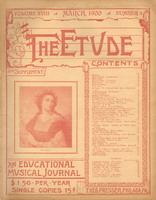It is the compass and capacity of the pedal section of an organ which give the instrument dignity and cause it to be unapproachable by any other musical instrument. In this respect even a grand symphony orchestra is always lacking, compared with the deep and pervading bass of the organ. In legitimate organ music, the pedal part has its own distinct voice, independent of the manual parts.
The attainment of the use of the pedals is not so difficult as it seems, providing one has previously obtained perfect control of manual technic; and the object of this brief article is to afford encouragement to beginners, in giving a few preliminary rules in relation to the use of the pedals.
The organ seat should be at such a height above the naturals that the sole of the foot will hang from its own weight, without any lifting of the knee, at a short distance above the natural key, almost touching it, without resting on it, so that the toe or heel moving from the ankle joint, without lifting the knee, will depress the pedal.
The first exercises in learning to play the pedals are to find the precise location of each key on the pedal clavier without looking at the feet. The position of each key may be firmly fixed in the mind, so that there will not be the slightest danger of a mistake, by first locating the relative position of the sharp with the natural keys which are adjacent.
The lowest C always being found without hesitation, the octave above, or the middle C of the keyboard, may at once be found by lightly touching the toe of either foot against the left side of C sharp. This should be practiced with both feet until the natural key may be touched without the least hesitation, and then the C of the higher octave should be found in the same manner.
Next should be found the position of the lowest E and the octave above, by touching the toe lightly on the right side of D sharp.
Next, the position of the lowest F and the octave above, by touching the left side of F sharp.
Next, the position of the lower B and the octave above, by touching the right side of A sharp.
Next, find the more difficult letters of D, G, and A, which are located within the position of the sharps, but which must be found by their relation to the adjacent sharps.
The novitiate in pedal playing can now write a series of original pedal exercises embodying these simple rules for finding the keys.
The next exercises should be a sequence of alternate fifths, as C for the left foot, G for the right foot, D [left], A [right], and so on, ascending and descending the compass of the keyboard.



